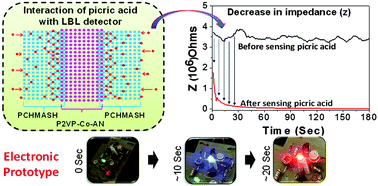Instant detection of picric acid vapour by developing layer by layer polymer detectors and an electronic prototype†
Abstract
The detection of an ultra-trace amount of picric acid has attracted substantial attention from the perspective of health, safety and environment. Due to its very low vapour pressure, the detection of picric acid vapour is quite challenging in comparison to that of the liquid phase. In this work, we have overcome this problem by developing layer by layer polymer detectors and an electronic prototype for instant detection of a ppm level concentration of picric acid vapour via impedance spectroscopy. The detectors constitute mainly two polymer layers with poly-cholesteryl methacrylate sulfonated hexene as the two outer layers and a copolymer of 2-vinyl pyridine with acrylonitrile as the middle layer. In the presence of the analyte, the detectors undergo a steep decrease in impedance within a few seconds. The thickness of the individual polymer layers plays a vital role and it was observed that the detector with thinner outer layers (0.25 mm) is more efficient as it shows about a 99% decrease in the impedance for 0.334 ppm of picric acid vapour within 10 seconds. The method is selective, the effect of varying humidity is negligible and the detection limit was found to be 0.006 ppm. Moreover, the detectors show reproducible results and are also consistent for a long period. Using these detectors, we have designed an electronic prototype for visual detection of picric acid at room temperature. Unlike other sophisticated techniques the prototype is simple, portable, and cost effective and can be used for the detection of higher grade explosives with various implications such as homeland security, forensic and criminal investigations and remediation of explosive manufacturing sites.


 Please wait while we load your content...
Please wait while we load your content...